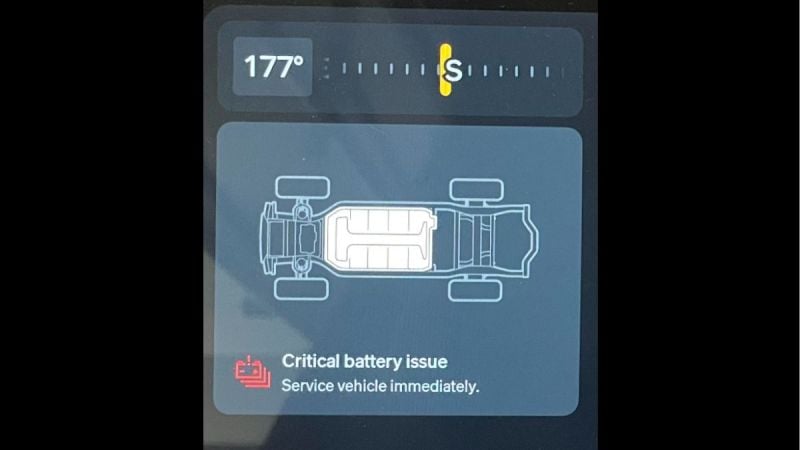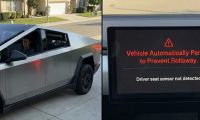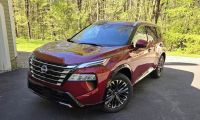People buy EVs like the Rivian R1T for the promise of a smarter and more connected driving experience. Having updates happen over the air, diagnostics being proactive, and having a truck that feels more like a living piece of tech than just a machine. But sometimes that promise breaks down in the most ironic ways. I was reminded of that when I came across a post from Bill Weidman in the “RIVIAN Electric Vehicles Discussion” group on Facebook this morning. His 2025 R1T was in the middle of a routine software update when it froze at 20% for hours, kicking off a bizarre sequence of failed resets, flashing lights, and reboot loops that left the truck completely undriveable. It even locked from one side while he waited helplessly for a tow. Here's his words on the situation:
“Add me to the Critical Battery Issue Club. I was in the midst of a software update and noticed on my phone that it had been stuck on 20% for 4–5 hours, so I hopped in the car and saw this message. It would try to start and then get an error message and then shut down and would reboot and continue the loop. Tried a soft reset and a hard reset. Hard reset seemed like it was going to work but then stalled out at 67% restarting and went back to the reboot loop. I’m waiting for a tow truck now. I can’t get in the door on one side now too. Nothing is showing up on screen now, but lights flash on for a few seconds and then stop and then it repeats. I’m not too optimistic. I’ve had zero problems so far other than very minor radio issues that were resolved through an update. Gear Guard doesn’t seem to work either, but I’ve been loving my 2025 R1T so far. Hopefully it will be resolved soon.”

A Software Update Turns Into a Major Headache
What Bill experienced is becoming an increasingly familiar story among Rivian owners: a seemingly minor update cascading into a total system failure. In his case, it was a stuck progress bar and endless reboot loop that locked him out and rendered his truck undriveable. This isn’t the kind of “over-the-air” magic Rivian advertises. In fact, it echoes issues shared by other owners whose trucks have suffered from strange startup behavior and mysterious update glitches.
It’s worth noting that over-the-air updates are meant to improve functionality without the need for service visits. But when things go wrong, owners are left without access to critical vehicle systems and in some cases, without even a way to unlock the doors. While Bill’s truck had performed flawlessly up to this point, this single failure has introduced an uncomfortable question: how fragile is the software layer that powers these advanced EVs?
The Community Weighs In With Similar Experiences
Curt Collinsworth chimed in with a cautionary tale of his own. “My battery died in Needles, CA on a road trip last weekend on the way home to LA. Had to divert to the Vegas service center. I had the same warning the day before and did a hard reset. The next day the car would not fast charge at all. Managed to level 2 charge enough to get to LV. RS1 needs a full high voltage battery replacement. Zero problems up to this point. Love the car but it seems they are having to replace a lot of these gen 1 packs.”
Curt’s comment not only validates Bill’s experience but also adds context about the larger pattern of high-voltage battery concerns in Rivian’s early production vehicles. As more trucks rack up mileage and undergo regular software updates, emerging failures like these may reveal issues that weren’t immediately apparent at delivery. We’ve seen similar cases before, like the one discussed in a detailed report on slow Rivian service timelines that revealed deeper concerns.
Giuseppe Gasparro offered a different angle: “If one side doesn’t work, it might be the 12V battery and not the high voltage. Fingers crossed.”
Giuseppe’s suggestion points toward another potential cause that Rivian owners have come to know all too well. When the 12V battery fails, it can throw the entire system into chaos and lead to issues like blocking door functions, preventing boot-up, and leading to confusing warning messages. And unlike the high-voltage pack, the 12V system is responsible for powering the truck’s basic electronics, startup procedures, and door locks. When it goes bad, the truck is effectively brain-dead until it gets a jump or a replacement.
David L Padgitt brought up a critical procedural insight: “Did you call service and go through troubleshooting with them? Also what is your state of charge? You should be above 30% before doing an update.”
His comment highlights a best practice that isn’t always made clear to Rivian owners. While the update system may allow installation below 30% state of charge, it doesn’t always mean it’s wise. Performing software updates with a borderline battery level can increase the chances of failure, especially if other systems are already under strain. This mirrors concerns discussed in situations where even Rivian loaner vehicles ended up failing and needed support, signaling that deeper reliability issues might be at play here.
Software That’s Still Maturing
Like I said, this certainly isn’t the first time a Rivian software update has gone sideways. For a company built on delivering premium and connected vehicles, these kinds of failures raise important questions about the update process itself. Are there enough safeguards in place to prevent an update from bricking the truck? Is there a better way to rollback updates when failures occur? These are questions Rivian’s team will need to prioritize as more owners begin to trust the platform with long-distance travel, remote access, and off-grid functionality.
Ironically, stories like Bill’s are emerging even among fans who genuinely love their vehicles. Many owners aren’t trying to bash Rivian. And to clarify, neither am I! We certainly want this company to succeed. But success requires attention to the small failures that affect everyday usability, especially when they leave a $90,000 truck dead in a driveway. And yet, stories like this owner’s transformation from EV skeptic to Rivian believer remind us why people are still choosing to stick with the brand despite setbacks like these.
As someone who closely follows these owner-reported issues, I think what makes Bill’s story stand out is how quickly an excellent ownership experience can pivot due to a software glitch. It’s not just about whether Rivian builds great trucks as it’s about whether they can build an ecosystem of trust. OTA updates should add confidence and not introduce fear. And when problems do happen, communication and support need to move faster than the reboot screen. What Bill experienced is a reminder that even the most innovative EVs are only as good as the systems that support them.
We’ve seen stories from other owners making bold transitions, like one who switched from a Kia EV6 to a Gen 2 Rivian R1S and couldn’t be happier. These narratives show that even in the face of breakdowns and battery scares, Rivian continues to inspire loyalty among a certain kind of driver: one who values innovation and is willing to weather some early growing pains.
Takeaways for Rivian Owners
- Never update with a low battery. While the system may let you proceed, it's safest to update when the truck is above 50%.
- Learn to recognize the signs of a 12V failure. In many cases, flashing lights, non-functional doors, and reboot loops can be traced to the auxiliary battery.
- Prepare for roadside scenarios. Keep towing info handy and consider a portable jump starter, especially if you're relying on the truck in remote areas.
- Follow community threads. Stories like Bill’s remind us why forums and Facebook groups can be essential tools for troubleshooting and preparation.
- Push for more transparency. If Rivian wants to win long-term loyalty, better communication during OTA failures and clearer update guidance could go a long way.
How About Your Opinion?
Has your Rivian ever struggled during an update, or left you dealing with a reboot loop like Bill’s experience?
What steps do you take to protect your vehicle during software changes or battery-related issues?
Let me know what you think in the comments below, I'd love to hear what you think.
Aram Krajekian is a young automotive journalist bringing a fresh perspective to his coverage of the evolving automotive landscape. Follow Aram on X and LinkedIn for daily news coverage about cars.
Image Sources: Rivian Gallery and the "RIVIAN Electric Vehicles Discussion" public Facebook group.












Comments
EVs are cute and all, but…
Permalink
EVs are cute and all, but who wants a brick in their driveway, right?
Our Rivian R1S had 3 recalls…
Permalink
In reply to EVs are cute and all, but… by Buzz Wired (not verified)
Our Rivian R1S had 3 recalls, service hasn't been able to schedule an appt. Vehicle had an anormaly while leaving parking lot. While driving onto street vehicle reversed (backwards) causing an accident, vehicle then shut down. The vehicle had been in shop 2 mos with problems. Now all service data including recalls have been deleted by Rivian. What can we do? A friend said he takes screen shots to save, but we didn't know there was a need to do screen shots